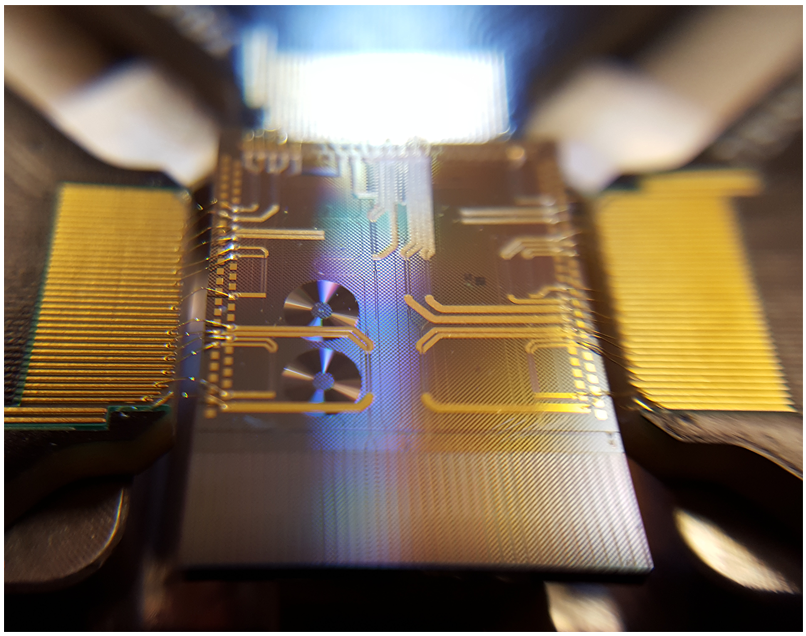Microcombs could be key in meeting bandwidth demands for artificial intelligence and data centres

A newly-published paper shows how a kind of “optical ruler”, or frequency comb, can greatly increase bandwidth in today’s data-saturated world.
In summary
- A new paper shows how a kind of “optical ruler”, or frequency comb, can greatly increase bandwidth in today’s data-saturated world.
- Microcombs have driven major advances in spectroscopy, metrology and more.
- Distinguished Professor David Moss is behind the paper published in prestigious journal Nature Photonics.
A newly-published paper from Swinburne University of Technology shows how a kind of “optical ruler”, or frequency comb, can greatly increase bandwidth in today’s data-saturated world. Integrated optical frequency comb sources, or microcombs, have driven major advances in spectroscopy, metrology and more.
Their potential in data transmission is especially promising, exceeding speeds of one petabit per second – 10 million times faster than a 100Mbit/s NBN connection.
Distinguished Professor David Moss, Director of the Optical Sciences Centre at Swinburne University of Technology, and Deputy Director of the Australian Research Council Centre of Excellence, the Centre for Optical Microcombs for Breakthrough Science (COMBS), has just published a key review paper – “Optical microcombs for ultrahigh-bandwidth communications” – in the prestigious journal Nature Photonics.
A laboratory-based optical frequency comb earned the 2005 Nobel Prize in physics. The technology has enabled breakthroughs in microwave photonics, frequency synthesis, optical ranging, quantum sources, and more, but one of its greatest successes has been in optical communications.
“The world’s optical fibre communications network forms the backbone of the global internet. Worldwide traffic is hundreds of terabits of data every second and growing exponentially at over 25 per cent per annum,” says Professor Moss.
While optics has greatly underpinned this, the exponentially increasing demand for data – being driven in large part by data centres and artificial intelligence – has created huge bottlenecks that will need radical technological innovations to overcome.
Integrated microcombs can generate hundreds of wavelengths coherently on a single chip and have now achieved levels of performance, reliability, stability and coherence allowing them to serve as integrated sources for ultrahigh capacity data transmission.
This paper reviews this progress and covers the state of this field, discussing promising new types of microcombs, new technologies such as space division multiplexing, and which markets microcombs may have the biggest initial impact.
“These devices have already enabled research demonstrations of communications at unprecedentedly ultra-high bandwidths and with greatly reduced energy consumption in an ultra-small integrated footprint. They could very well be a game changer in meeting growing bandwidth demands – particularly for data centres – and reducing energy consumption to perform well beyond existing technology,” says Professor Moss.
The review was co-authored by Associate Professor Bill Corcoran at Monash University, Professor Arnan Mitchell at RMIT University in Melbourne, Professor Roberto Morandotti at the INRS-EMT in Canada, and Professor Leif Oxenlowe at the Danish Technical University in Copenhagen, Denmark.
-
Media Enquiries
Related articles
-

- Science
- University
Swinburne looks to the STaRS for global research talent
Swinburne Talented Researcher Scheme (STaRS) is a strategic initiative designed to enhance Swinburne’s ability to attract and retain world-class research talent
Wednesday 30 July 2025 -

- Science
- University
Events at Swinburne to celebrate National Science Week 2025
As a leading university for science, Swinburne is proud to champion the outstanding contributions of our scientists to the global stage this National Science Week.
Wednesday 30 July 2025 -

- Technology
- Science
- University
- Engineering
Swinburne to advance battery life and EV cybersecurity with Australian Research Council grants
Swinburne has secured two grants from Australian Research Councils to advance research in energy storage and cybersecurity.
Wednesday 02 July 2025 -

- Technology
- Science
- University
- Sustainability
Swinburne powers breakthroughs in sustainable mining and materials technology
Swinburne innovators have been awarded $4 million in funding from the Australian Government, driving Australia’s future in sustainable innovation through two groundbreaking projects.
Tuesday 15 July 2025 -

- Science
Microcombs could be key in meeting bandwidth demands for artificial intelligence and data centres
A newly-published paper shows how a kind of “optical ruler”, or frequency comb, can greatly increase bandwidth in today’s data-saturated world.
Thursday 08 May 2025

